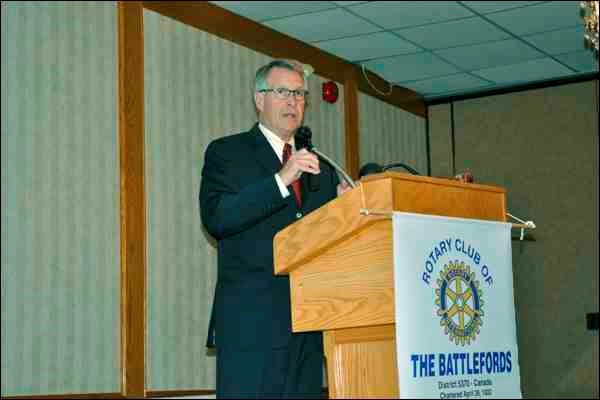The former CEO of Cameco Corporation sees a bright future for the uranium industry in the province.
Gerald Grandey, who retired in 2011 as CEO of Cameco, spoke to the Battlefords Rotary Club meeting at the Tropical Inn in North Battleford Monday.
Grandey had previously spoken at the Battlefords Rotary Club about Ronald McDonald House in Saskatoon and its expansion plans, but was invited back at the urging of Rotary members Harvey and Jean Walker to talk about uranium mining and nuclear energy.
What Grandey had to say was in line with what many other business presenters have told Battlefords audiences in the past several months: that there is plenty of demand for Saskatchewan resources from markets around the world.
"The future of the province looks incredibly bright," said Grandey. "My former company, Cameco, is certainly part and has been part of that boom."
Grandey said there is an "insatiable demand for energy around the world."
He identified markets such as China and India as well as Korea and the United Arab Emirates as areas of growth for Saskatchewan uranium.
"This is where the most significant growth has taken place," Grandey noted.
He said the Canadian government has been supportive in negotiating bilateral nuclear co-operation agreements with these countries.
Grandey said there has also been support from the province in trade missions to China and India as well as collaborative efforts to bring education and training to communities and to the workforce.
Grandey cited Saskatchewan's political stability, strong infrastructure and educated and capable workforce as positives.
He pointed to Cameco's 5,000 employees and noted the company accounts for 16 per cent of worldwide production, with Saskatchewan forming the backbone of its operation. He described operations in locations such as McArthur River, Key Lake, Rabbit Lake and Cigar Lake. The former Cameco CEO's assessment of the industry was upbeat.
"The uranium industry in this province is positioned for expansion, positioned for growth," said Grandey.
Grandey did acknowledge some of the challenges the industry had faced in recent years.
He said the events of March 11, 2011 impacted the industry. The Japanese earthquake and tsunami resulted in the meltdown at three nuclear power plants in Japan, followed by the hydrogen explosion at Fukushima that released radioactivity into the atmosphere.
"It's one of those moments when you know exactly what you're doing," Grandey said.
He was in Mumbai, India when the disaster happened.
"We in the industry refer to it as our 3/11," Grandey said.
While Grandey acknowledged his industry had to learn lessons from that disaster, "the future of the industry remains bright, and demand for Saskatchewan uranium remains strong."
"The world's appetite for energy is increasing every day," said Grandey, who noted the world's demand for electricity will go up 70 per cent in the next 20 years.
Developing countries will need that energy for potable water, heat and other necessities, he said. Nuclear offers a "safe clean and reliable" source of power, he said.
He noted uranium consumption would be 220 million pounds by 2022, compared to 170 million pounds today.
One reason Grandey expects demand for uranium to increase has something to do with the disarmament and dismantling of 20,000 Russian nuclear warheads.
As a result of that disarmament, highly-enriched uranium from those has been blended down to produce fuel that is usable to produce electricity usable in commercial nuclear power plants, said Grandey.
However the last of the Russian weapons is being dismantled this year.
"That source of supply that has been filling that gap is going to have to get replaced," said Grandey.
That is one reason there will be demand for uranium, Grandey pointed out. Once new plant builds in China accelerate and excess inventories are cleared, "then you begin to see a price response."
"Certainly more nuclear plants equates into new demand," said Grandey.



.png;w=120;h=80;mode=crop)
